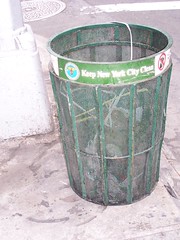Make sure you say what matters to you
In the same discussion realm as "civic engagement" I've been thinking quite a bit about visual cues in the built environment as a way to communicate what the community values.
Many communities across the country have historical markers for designated buildings, which explain why the buildings are significant to local and/or national history.
Neighborhoods may have gateway gardens and entry signage, which help build community identity.
And trash cans that explain what they're for help communicate to people that a clean environment also matters.
I know it should be obvious what city-provided trash cans are for, but plenty of people manage to not use them regardless.
Maybe we need to think about this more thoroughly.
DC has few historical markers, doesn't brand its trash cans, doesn't use bus shelters as opportunities for communicating about neighborhood history and building neighborhood identity, and has the most godawful "historic district" marking signs around (at least in my opinion).
Is it any wonder that you get people suggesting we tear down historically eligible commercial buildings for parking lots and dirty streets?




0 Comments:
Post a Comment
<< Home